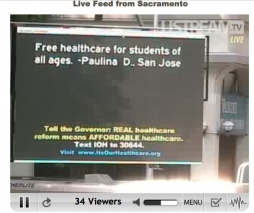We reported a few days ago on the use of a text-to-screen campaign by the advocacy coalition It's OUR Healthcare! (IOH) in California. Now that the campaign is over, we've interviewed the organizers for more details on this innovative use of SMS in political advocacy.
Matt Lockshin, the online organizer for the It's OUR Healthcare! campaign sat down with us for a conversation. Lockshin told us that although the campaign dealt with some technical challenges, he was pleased with the quantity of SMS messages received and the response from media, political advocacy groups, and people in California.
Although he has plenty of experience as a grassroots organizer, Lockshin said he'd never used text messaging before in his work. The campaign came up with the text-to-screen idea after trying a lot of conventional advocacy techniques -- email, faxes, phone calls, handwritten notes, and even 48-hour-vigils -- and were looking for some new tactics. "We'd been taking everything out of our bag of tricks that we could, and were looking for something new and different that would hit our targets at a different angle." He had seen a similar approach -- a screen using Wiffiti at the Yearly Kos conference -- and was inspired to try a similar tool for IOH's advocacy campaign. The campaign liked the idea of producing live content from individuals texted in on a public screen that allowed the voices of people all across the state to be heard. "Even though people couldn't participate physically they could still make sure that their message was prominently seen," said Lockshin.
IOH set up the screen in Sacramento, about 150 feet from the door of the Capitol building. The screen, which Lockshin said was about 9' by 12', broadcast in close to real time SMS messages sent from supporters throughout the state of California. Because of the variety of groups represented in the IOH coalition -- consumer advocates, senior citizens, labor groups, people of faith, and health advocates -- SMS messages from many different perspectives were visible on the screen throughout the day. Smartly, the campaign also provided a live video feed of the screen on IOH's website, so visitors to the site and press could see the text messages appear on the screen on the web. Video clips of the live feed are available here.
According to Lockshin, the group received about 600 SMS messages during the day of the campaign that were broadcast. The campaign was marketed through various methods, including email alerts to members of the coalition, a web form that allowed users to sign up for text messages, Facebook flyers, and advertising through the individual coalition members. The response rate was high; Locksmith said that about 47% of the people who had previously opted in to the campaign sent an SMS on Wednesday.
The text message campaign was a two step process. First, the user would send the keyword "IOH" to short code 30644, and then receive a text message back that would allow them to send a message to the live feed. Some of the organizers at the different partner organizations also arranged "watch parties" and got everyone in their offices to send text messages. Lockshin attributes some of the success of the campaign to the mixed media nature of the advertising. "I think that part of the reason it was successful is because it wasn't just email and it wasn't just text ," he said.
Lockshin said that some users didn't have much experience with SMS. "We had this barrier of text understanding," he said. He said that some users didn't understand the terms 'keyword' or 'short code', and others didn't know that text messages had a 160 character limit. One caller said that she would wait for her son to get home to teach her how to send an SMS. Some users also didn't understand that after texting "IOH" they would receive a confirmation SMS only upon which they were then able to comment for the screen.
The campaign used Mobile Commons as its text-to-screen vendor and Blackrock as its consultant. The campaign encountered some technical issues with its flash set up, but overall, it seemed to have performed mostly according to plan. Organizers used two computers equipped with cellular broadband cards. One computer was attached to the video screen and was running a flash player. The other computer was connected to a video camera which was aimed at the screen, sending a live feed to the IOH website using Ustream. When text messages were sent to the mCommons short code, they were published as an RSS feed and then displayed on the screen. Lockshin says that many of the problems were related to inexperience and the short time that the IOH had to setup the campaign. "The person who did the flash viewer didn't know what to expect and neither did we," he said. "We could make it better, especially with more lead time."
The verdict is still out on Schwarzenegger's health care proposal. Lockshin said that the group received positive responses from both people inside the Capitol who could see the text screen and from people outside the building. However, whether the SMS campaign directly affected the legislation or not, Lockshin sees the campaign as a grand success. He said that many members of the coalition and other political activist groups are seeing the campaign as a new tactic, one that has potential for future political advocacy. "I think that from an internal political perspective it really energized and motivated a lot of people," he said. "I think that especially with an issue like this activists and members of these groups like to see that we're doing new things that are interesting and engaging. This really showed the power of text messaging."


Post new comment